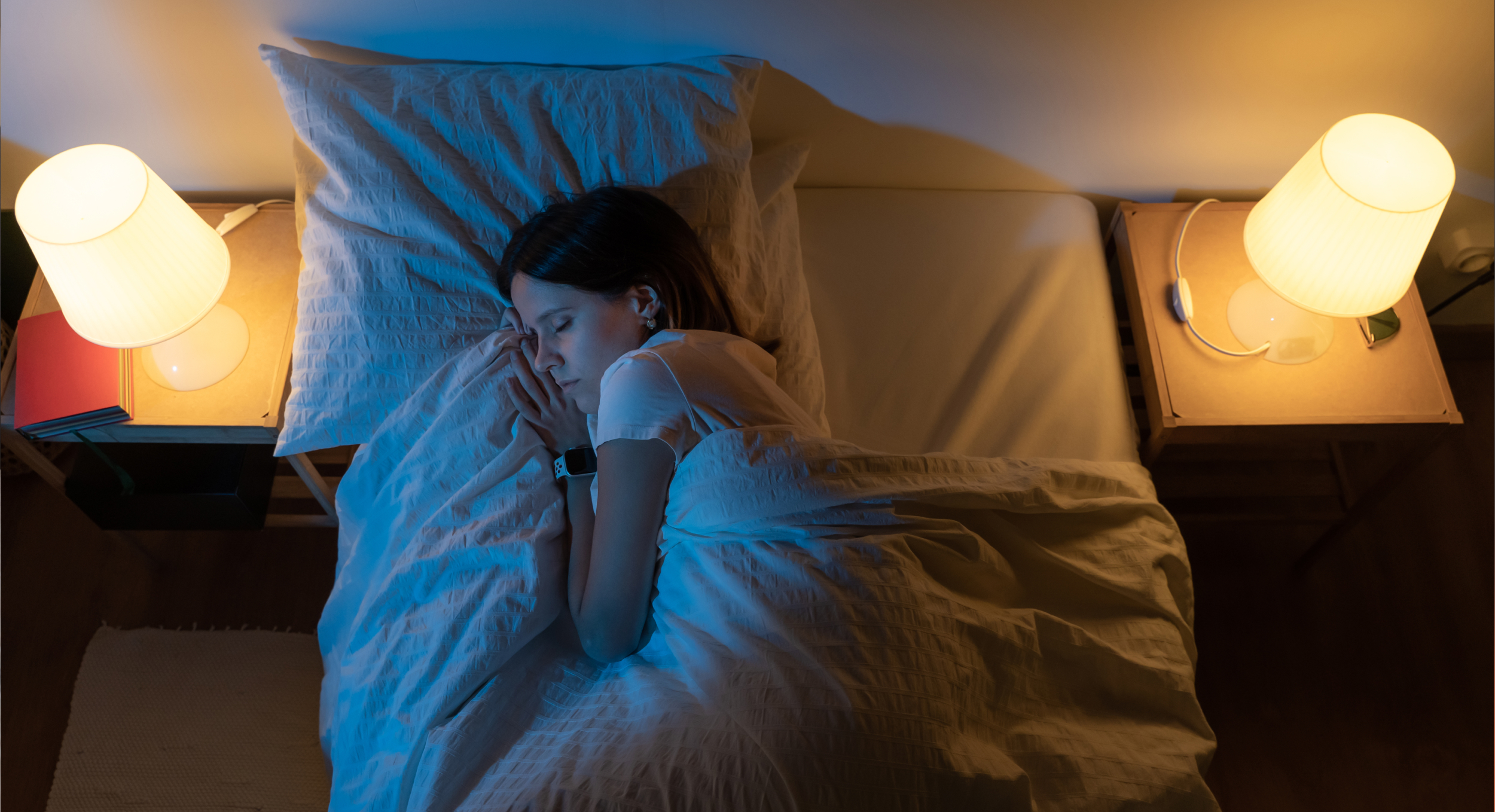
Types of Meditation for Anxiety Treatment
Meditation is a word that contains in itself dozens of techniques and practices, all of which are great for reducing anxiety. However, some people, especially beginners may struggle a bit with choosing the one(s) that work best for them.
In this article, we’ll discover most common and beginner-friendly types of meditation for anxiety and also give you tips on how to remain consistent with your practice.
Bedtime Meditation for Anxiety
Bedtime meditation is undoubtedly of the most popular ways of reducing anxiety – let’s dive deeper into what it is and what if offers:
Definition and Benefits
Bedtime meditation for anxiety is a practice that involves relaxing and calming meditation exercises aimed at reducing stress and helping restful sleep. It often revolves around paying attention to your breath and letting go of your rushing thoughts and stress.
Bedtime meditation can help you noticeably lower your anxiety levels and feel more at peace with yourself. sleep easier and get more undisturbed slumber for longer periods of time thanks to it. You’ll discover that yoga cultivates inner peace, quiets the mind, and minimizes distracting thoughts as you practice, leaving you feeling more at ease and ready to go asleep. Overall, nighttime meditation is an excellent method for controlling anxiety and encouraging a calm transition into a sound night’s sleep.
Techniques and Practices
1. Progressive Muscle Relaxation
This simple technique helps relieve tension in your muscles – to do that, you’ll need to alternate between contracting and relaxing various muscle groups in your body. Starting with your toes, intentionally tense each of the muscles for a few seconds. Then, release the contractions and concentrate on the soothing feeling this action provides.
2. Guided Imagery Meditation
To unwind both your body and mind, you can also use guided imagery – visualizing serene settings or experiences. You can use your imagination to picture yourself in a calm atmosphere, such as a beach or forest, or you can listen to pre-recorded guided meditations (which you can find in our Smart Meditation app). To fully embrace the experience and let go of stressful thoughts, try to pay attention not just to the image you create, but also to the noises, smells, and sensations.
3. Body Scan Meditation
During this exercise, you’ll focus on various body parts, starting with your head and working your way down to your toes. Concentrate on any tensions or sensations you feel, but don’t judge them – simply acknowledge their presence. Body scans help you relieve physical and emotional stress by purposefully relaxing those areas, which will help you feel peaceful before going to bed.
Tips for Effective Bedtime Meditation
Create a tranquil atmosphere: find a peaceful, comfortable area where you won’t be bothered. Make sure the environment is relaxing by turning down the lights, you may even turn on some quiet music, if it doesn’t disturb you.
Set up a routine: designate a set time for your bedtime meditation for anxiety. Your body and mind will start to respond to your sessions better and get ready for sleep once you make a consistent habit out of it.
Be kind to yourself: it’s common for your thoughts to wander when you are meditating – don’t worry and don’t start telling yourself off. Softly refocus without passing judgment on yourself, remain calm and patient.
Use guided meditation apps or recordings: Try utilizing guided meditation apps or recordings if you’re new to meditation or find it difficult to focus on your own. Apps like Smart Meditation provide you clear directions, while the soothing voices used in the audio tracks help you relax.
Examples of Bedtime Meditations for Anxiety
Some of the best bedtime meditations for anxiety are provided by guided meditation. Guided meditation is a practice where your session is assisted or guided by a third party – this could be a live coach or a podcast, an audio track or a video.
For instance, in our Smart Meditation app you can find such audio tracks for deep sleep, peace and joy as yoga nidra and shavasana. These practices will help you feel more in harmony with yourself and let you be guided through your session with minimum stress and maximum relaxation.
Beginner’s Meditation for Anxiety
Meditation, despite its relaxing nature may seem a bit intimidating for beginners. If you are one, let’s ease you into this great practice:
Importance of Starting Slow
Starting a daily meditation for anxiety practice, above all, means keeping it slow and building a strong foundation overtime. Be gentle and kind to yourself as you begin your meditation journey. You should also expect delays in getting results, and this is completely normal – instead of pushing yourself too hard from the start, focus on consistency. Start with workouts that are shorter (5 to 10 minutes) and gradually lengthen them at your own pace. Since meditation is a skill that improves with practice, treat each session as a chance to expand your awareness and build a calmer frame of mind.
Basic Meditation Techniques
Some common beginners meditation for anxiety techniques include breath awareness, loving-kindness, and mantra meditation:
1. Breath Awareness Meditation
This technique involves concentrating on your breath and observing how the air naturally enters and exits your body. Find yourself a quiet place, get yourself into a comfortable position, close your eyes and start breathing at your preferred pace. If your thoughts begin to stray, gently refocus them on your breathing.
2. Loving-Kindness Meditation
The main goal of this method is to develop love, compassion, and kindness for both you and other people. Start by wishing yourself well and sending kind thoughts, such as “May I be happy, healthy, and safe.” Send your best wishes to family, friends, and even those who you might see as your enemies.
3. Mantra Meditation
This beginners meditation for anxiety is about focusing on a calming word or phrase that serves as your personal mantra. With each inhalation, silently recite your chosen mantra as you close your eyes and take a deep breath. If you get any wandering thoughts, refocus your attention on the chant.
Creating a Supportive Environment
Setting up a comfortable environment for your daily anxiety meditation can consist of many things. Naturally, the first things that come to mind are dedicating a special place in your home for your activities or finding someone you share your experiences with.
At the same time, one very important, yet sometimes overlooked element, is a meditation app. Apps like Smart Meditation can be your most loyal companions in your self-exploration and self-betterment. They can help you remain consistent with daily reminders, enrich your experience with guided meditation courses and track your progress with completed session counters.
Daily Anxiety Meditation
Staying consistent with your daily anxiety meditation isn’t always easy – that’s why we’ve highlighted the following five tips to help you with self-discipline:
Incorporating Meditation into Daily Routine
By incorporating meditation into your daily activities, you establish a regular routine that helps you maintain consistency. Find a time that suits you, whether it’s in the morning or the evening, and set up a special area where you can unwind and concentrate. Also find a daily activity which you could connect with your daily anxiety meditation sessions – you could mediate after taking a shower, for instance.
Mindfulness Meditation for Anxiety
Mindfulness meditation is one of the easiest techniques and can serve as your go-to choice on any day when you are not in the right mindset for more complicated activities. Take a few deep breaths, get into a comfortable position, and just focus on the here and now. As thoughts come and go, simply acknowledge them without passing judgment.
Walking Meditation for Anxiety Relief
If you want to mix things up to keep your meditation streak, go for a leisurely stroll in a tranquil outdoor area. Pay attention to how your feet feel, to the outdoor noises, to the sun’s warmth. Put your anxious thoughts aside and focus on your feet touching the ground. Walking meditation can help re-establish your connection to nature and reduce stress as well as any other types of meditation for anxiety.
Journaling as a Complementary Practice
Every day, set aside a little period of time to record your ideas, emotions, and experiences in your meditation journal. You can express yourself freely and think back on your meditation – write down any revelations or “aha” moments you have and don’t hesitate to let any fears or anxieties out onto the paper. Journaling can provide a creative outlet and a way to manage emotions by developing self-awareness.
Maintaining Consistency and Motivation
Finally, reminders or meditation applications can also help you stay motivated. Being aware that some days may feel easier than others, approach each meditation session with an open mind and a non-judgmental attitude. You can only build a strong foundation for controlling anxiety by remaining consistent – going in and out of meditation is not recommended, although it’s still definitely better than no meditation at all.
Conclusion
Such techniques as progressive muscle relaxation, breath awareness, guided imagery and mantras are all great choices for easy-to-do meditation. You may prefer to meditate during the day, but if one of your main goals is getting restful sleep, try bedtime meditations. It’s also very important to stay consistent – journaling, incorporating meditations into your routine and trying new meditation methods can help you with that.
And if you’d like to enhance your meditation experience with guided meditation, feel free to try the Smart Meditation app – it doesn’t only contain high-quality, immersive tracks, but also helps you stay motivated and consistent with reminders and progress trackers.






